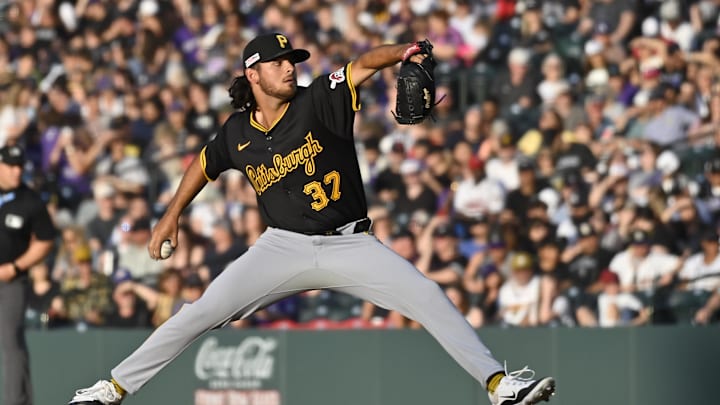If you’ve watched Major League Baseball for any amount of time, you’ve probably heard of the term “the Coors Effect.” It refers to the Colorado Rockies’ home stadium, Coors Field. While nothing about the stadium in and of itself makes it hitter-friendly, its location does as it’s the highest above-sea level park in MLB, making the atmosphere thinner than average.
Pittsburgh Pirates ace Jared Jones learned this the hard way on Saturday night. This was the Pirates’ first series against the Rockies on their home turf, and the second game of the series did not go Jones’ way.
Jones pitched 4.2 innings, and while he struck out six, he also allowed four walks and a home run. In total, Jones allowed a season-high six earned runs. The Coors Effect definitely impacts fly balls, and Jones is a fly ball pitcher, so that was already a bad combination. Jones only allowed one home run, but there’s an entirely different factor that many don’t consider.
Pitches behave entirely differently in Coors Field because of the thinner atmosphere. Jones averaged around 97 MPH on his fastball with about 2500 RPM in his game at Coors, both of which were about average for him. But his fastball gained three inches of vertical movement (from 12 inches on average to 15 inches). On paper, that might not seem like a massive difference, but a fastball with 12 inches of drop vs 15 inches of drop is the difference between ranking 35th in fastball vertical movement to 200th.
Fifteen inches of vertical movement is a single-game career-high for Jones, but his high spin curveball also suffered similar effects. He only threw it six times but had just 46 inches of vertical break and two inches of horizontal break. So far in his rookie season, Jones has typically averaged 54 inches of vertical break and six inches of horizontal movement on the same pitch. His spin rate was once again around his career norm of 2650 RPM, and while he was throwing it slightly harder at 81.5 MPH, that shouldn’t be enough to subtract over a half-foot of movement from the pitch.
This isn’t just an issue that Jones is suffering from either. The average four-seam fastball in Coors Field sits 94 MPH with 2275 RPM and 18 inches of vertical movement. Fastballs thrown outside of Coors have nearly identical velocity and spin, but with 15 inches of vertical movement (with no other stadium being within an inch and a half). The same goes for curveballs. The average vertical movement for a curveball in Coors Field is 49.9 inches, while curveballs in all other parks average 53.4 inches. Those few inches of added break could be the difference between painting the black or leaving a pitch in a hittable spot.
This isn't the only example from 2024, either. San Diego Padres' lefty Adrian Morejon's fastball averages 12.7 inches of vertical drop this year. At Coors Field, Morejon averaged 16.1 inches of drop. Arizona Diamondbacks' ace Zac Gallen throws a four-seamer with 15 inches of drop. At Coors Field, he hit 17.7 inches of drop. There's a reason why the Rockies are at the bottom of the leaderboard in fastball spin rate.
The scientific term here is "the magnus effect," which states “the force exerted on a rapidly spinning cylinder or sphere moving through air or another fluid in a direction at an angle to the axis of spin. This force is responsible for the swerving of balls when hit or thrown with spin.” Spin simply is not effective in environment with thin air.
Jones’ first ever start at Coors Field went about how you’d expect from a 22-year-old who was essentially trying to fight gravity and mother nature. Jones’ stuff isn’t built to work well in such a setting, and it definitely showed. It’s hard to adjust mid-game to something like this, especially when he's probably never experienced it before. The start (and the game in general) didn’t go Jones’ or the Pirates' way, but he shouldn’t let this affect him. There's not much Jones could have done to prepare for it.
